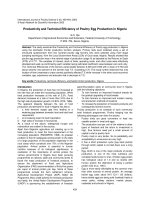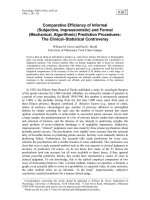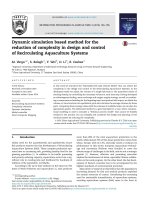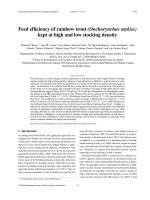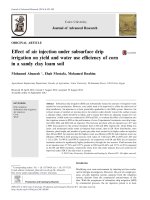Comparative efficiency of conventional and NIR based technique for proximate composition of pigeon pea, soybean and rice cultivars
Bạn đang xem bản rút gọn của tài liệu. Xem và tải ngay bản đầy đủ của tài liệu tại đây (354.32 KB, 10 trang )
Int.J.Curr.Microbiol.App.Sci (2018) 7(1): 773-782
International Journal of Current Microbiology and Applied Sciences
ISSN: 2319-7706 Volume 7 Number 01 (2018)
Journal homepage:
Original Research Article
/>
Comparative Efficiency of Conventional and NIR Based Technique for
Proximate Composition of Pigeon Pea, Soybean and Rice Cultivars
Susheel Singh*, Sweta Patel, Nitesh Litoria, Kelvin Gandhi, Priti Faldu and K.G. Patel
Food Quality Testing Laboratory, N.M. College of Agriculture, Navsari Agricultural
University, Navsari-396 450, Gujarat, India
*Corresponding author
ABSTRACT
Keywords
Near Infrared (NIR)
spectroscopy,
Protein, Fiber, Oil,
Soybean, Rice,
Pigeon pea
Article Info
Accepted:
06 December 2017
Available Online:
10 January 2018
Proximate composition of food crops is an essential and inevitable tool to identify their
ability to suffice the nutritional security of society. Creating database for the key
components of biochemical composition is also an essential step to categorized food crops
on nutritional supplanting capacity. Conventionally, for the biochemical characterization
was performed with tedious and time consuming proximate and wet methods which did
not match with current analytical requirements viz., quick, easy cheap, effective rugged
and accurate. Near Infrared (NIR) spectroscopy expected to fulfill the above mention
characters. Therefore, a study was performed to determine the analytical efficiency of
traditional as well as NIR spectroscopic methods to determine Protein, fiber and oil
contentfrom31, 25 and 17 commonly available cultivars of soybean, rice and pigeon pea,
respectively. A NIR spectrophotometer (Instalab7200) was standardized with different
varieties of above crops as per the protocol. The analytical results obtained with NIR
spectroscopic technique was significantly correlated with those from conventional method
with high degree of repeatability (% RSD≈10) in results, cost effectiveness and speed of
analysis. The outcome of this work indicates that NIR spectroscopy has potential to serve
as an accurate and rapid alternative method for quantifying the common biochemical
components of different cultivars of soybean, rice and pigeon pea with acceptable
accuracy, precision and reproducibility.
Introduction
In the food industry, food safety and quality
are still performed as an important issue all
over the world, which are directly related to
people’s health and social progress.
Consumers are gradually looking for quality
seals and trust marks on food products, and
expect manufacturers and retailers to provide
products of high quality. All of these factors
have underlined the need for reliable
techniques to evaluate the food quality
(Haiyan and Yong, 2007). Protein, Fiber and
fat content are the routine biochemical food
quality parameters which are employed worldwide to determine the quality of any food
matrices. Traditional analytical methods viz.
Folin-Lowry (Protein), Gravimetric (fiber) and
Soxhlet method (oil content) are time tested
but are tedious and time consuming. These
methods are suitable for laboratory level
analysis where representative samples can be
773
Int.J.Curr.Microbiol.App.Sci (2018) 7(1): 773-782
analyzed. But at industrial level, these
methods are not fitted in the scheme and could
not serve the purpose of screening or
monitoring of quality parameters of each
product. Near infra-red spectroscopy (NIRS)
provides an alternative, non-destructive
technology for measuring constituents of
biological materials with little sample
preparation and is able to provide reliable and
accurate results of larger range of samples of
multiple properties at one time (Stuth et al.,
2003).
Conventional analysis
NIRS is widely used for the quantitative
determination of quality attributes such as
moisture, protein, fat, and kernel hardness in
agriculture and food products (Williams and
Norris, 2001).NIRS is broadly accepted in
quality assessment of foods, beverages and
various other matrices in contemporary
scientific fraternity.
For NIR analysis sample were grounded and
passed through 0.5 mm sieve to prepare fine
powder. Powder was dried in oven at 50 C
for 6 hrs to remove moisture. Protein, fiber
and oil content of samples were analyzed
using NIR Product Analyzer (Instalab® 700,
DICKEY-John Corporation). Throughout the
experiment instrument was operated at a
constant temperature (50±10oC) with 40–
50%relative humidity.
NIRS is an accepted method to predict forage
fiber traits of barley straw (Mathison et al.,
1999), rice (Kong et al., 2005; Jin, 2007),
green cereal crops (Bruno-Soares et al., 1998),
leguminous shrubs (Garcia et al., 2004), and
oat hulls (Redaelli, 2007).
The objective of this study was to determine
the analytical efficiency of Near Infrared
spectroscopy over traditional analytical
methods for estimation of biochemical quality
parameters such as protein, fiber and oil
content of rice, soybean and pigeon pea.
Materials and Methods
Sampling
Different cultivars of soybean, rice and pigeon
pea were taken for comparative study for their
biochemical analysis. Total 31, 25 and 17
commonly available cultivars of soybean, rice
and pigeon pea were collected respectively
(Table 1).
For analysis of sample using conventional
method, samples were grounded in fine
powder. Protein was estimated by the method
of Folin-Lowry et al., (1951). Fat content was
estimated by Soxhelt extraction method
(Sadasivam et al., 1992). Fiber content was
estimated by Gravimetric method (AOAC,
1990).
NIR analysis
Calibration of NIR product analyzer for
protein, fiber and oil
Calibrations were validated by analyzing an
additional 25 samples each of soy bean, rice
and pigeon pea. Bias and standard error of
prediction (SEP) were calculated. Before NIR
analysis, the samples were kept at room
temperature (25 oC) for 6 h to balance the
moisture and temperature as these factors can
affect the reflectance and absorbance of NIR
wave. A small cup was used for scanning of
the sample with full spectrum (400–2500 nm)
taking about 15 g of each sample. The
reflectance spectra (log1/R) from 400 to 2500
nm were recorded at 10 nm intervals. After
incorporating the laboratory value in spectra
file, the regression equation was developed
and simultaneously, various trial and error
methods of mathematics under modified
partial least square (mPLS) were also
developed to find out a best regression
774
Int.J.Curr.Microbiol.App.Sci (2018) 7(1): 773-782
equation for prediction of different
parameters. The calibration were carried out at
five different wave lengths viz., 2310, 2230,
2180, 2100, 1940, 1680 nm to find out the best
reflectance for determining the oil, fiber and
protein content from of soybean, rice and
pigeon pea.
Across the near-infrared spectrum, there are
wavelengths
typically
unaffected
by
composition. Their main source of variation is
from particle size differences. Filter 5 (1680
nm) is such a wavelength. A wavelength
associated with oil (2230 nm), and a
wavelength associated with protein (2310 nm)
were identified on the basis of calibration).
For analysis 20 to 30 g fine dried powder was
placed in sample cup and scanned at 400 –
2500 nm for analysis. The NIR ray scan
through the sample as it rotates within it
conferment and immediately, the result was
displayed on the NIR product analyzer screen
in less than 1 to 2 min (Chukwu et al., 2014).
Each analysis was carried out in triplicates.
Statistical analysis
Data obtained in this research work were
statistically analyzed to determine the level of
significance in the parameters evaluated when
the two methods were applied. Proximate
compositions analysis was replicated (n = 3)
in both methods. Results presented are mean
values of each determination + standard error
mean (SEM). Completely Randomized Block
Design (CRD) was used to study the variation
in protein, fiber and oil content in different
genotypes of rice, soybean and pigeon pea due
to different analytical techniques.
Results and Discussion
Analytical efficiency
The results obtained in study of protein, fiber
and oil content in 31 soybean genotypes is
given in table 1. The protein, oil and fiber
content recorded in the study were found in
the range from 26.0 to 37.9%, 13.4-19.9%
and3.5 to 5.7% respectively when analyzed
either with traditional or NIR product
analyzer. The CV% which is an indicator of
variation in repetitive analysis was found
lesser in NIR product analyzer with respect to
respective conventional analytical techniques
adopted to determine protein, oil and fiber
content in soybean. The analytical results
obtained from both techniques were highly
correlated at 95% and 99% confidence interval
in soybean.
Similar trend was also observed in rice and
pigeon pea varieties which are given in table 2
and 3 respectively. The analytical results of 25
rice verities by both the methods shows that
protein content was in 7.6 to 9.3% range, fiber
content varied from 0.45 to 0.80%, whereas,
oil content showed 2.5 to 3.77% range. High
correlation (significant at 1%) (r = 0.86)
between Folin-Lawry and NIRS Protein
values were observed in result. Likewise,
observing the result of 17 varieties of pigeon
pea, it showed that the protein content ranged
from 22.1 to 28.4%, oil content ranged from
1.4 to 2.4%, whereas, the fiber content varied
from 4.2 to 6.4%. High correlation (significant
at 1%) (r = 0.61) between Soxhlet and NIRS
oil values were observed.
A higher repeatability was observed in the
results obtained with NIR over other
techniques. The maximum %RSD of different
routine methods of protein, oil and fiber was
in the range of 0.2 to 10.2. Here, the values of
% RSD and CV% of precision study for NIR
method for protein, oil and fiber analysis were
within the acceptable limits (<10% for RSD
and <5% for CV % in majority of cases)
(Table 1 to 3). The measured value of protein,
oil and fiber in NIR were significantly
correlated with respective measured value of
protein, oil and fiber in routine method (Table
775
Int.J.Curr.Microbiol.App.Sci (2018) 7(1): 773-782
4). Several scientists working on myriad of
crops e.g. Soybean (Lee et al., 2011;
Hymawitz et al., 1974; Rinne et al., 1975),
Brown Rice (Bagchi et al., 2015), straw berry
(Jin, 1994) had already proven that NIR
reflectance technique can successfully be
adopted over conventional methods for
various biochemical quality parameters.
Rosenthal (1973) mentioned in his report an
instrument for the determination of moisture,
oil, and protein content rapidly and accurately
ingrain and grain products by means of the
NIR technique. The findings of our study
further strengthen this statement and found
that NIRS can be used for the analysis of
protein oil and fiber content in soybean, rice
and pigeon pea with acceptable analytical
criteria.
Table.1 Details of experimental materials
Crop
Cultivars
Sample site
Total no.
Sample
of
Size
samples
Soybean JS-84-1615, DS-112, JS-75-10, PK-805, JS-79-
KVK, Amreli,
190, JS-81-607, PK-805, AGS-51, DS-86-75,
JAU and Niger
AMR-SEL-KH-06, EC-93601, PK-820, DS-
Research
71-1-29, J-563, JS-79-4-11, SL-20, JS-335,
Centre,
Gujarat soybean-1, Gujarat soybean-2, Gujarat
N.A.U.,
soybean-3, JS-793, PK-472, MACS-450, JS-
Vanarasi.
31
100g
25
100g
17
100g
93-05, BRAG, KB-85, AGS-46, AMS-25,
AMS-48, AGS-51, MACS-1252
Rice
NAUR -1, GNR-2, GNR-3, GNR-4, IET-
Rice research
22084, IET-22224, IET-22598, IET-22569,
station,
IET-22565, PR-113, MTW-1010, GR-104, IR-
Navsari
64, LG/GT, SGSYGSREE, IET-21515, IET22095, GURJARI, MASURI, GAR-13, GAR1, GAR-103, GR-6, GR-11, GR-10
Pigeon
Vaishali, GT-102, GT-103, GT-101, GT-100,
Pulse Research
pea
GT-1, AGT-2, BDN-2, P-992, ICPL-87119,
station,
ICPL-87, GTH-1, C-11, UPAS-120, 288-B,
Navsari
2199-B, 2188-B
776
Int.J.Curr.Microbiol.App.Sci (2018) 7(1): 773-782
Table.2 Protein, oil and fibre content in different cultivars of Soybean
Varieties
JS-84-1615
DS-112
JS-75-10
PK-805
JS-79-190
JS-81-607
PK-805
AGS-51
DS-86-75
AMR-SEL-KH-06
EC-93601
PK-820
DS-71-1-29
J-563
JS-79-4-11
SL-20
JS-335
Gujarat soybean-1
Gujarat soybean-2
Gujarat soybean-3
JS-793
PK-472
MACS-450
JS-93-05
BRAG
KB-85
AGS-46
AMS-25
AMS-48
AGS-51
MACS-1252
Mean
Minimum
Maximum
S.Em+
CD
CV%
Protein (%)
Folin-Lowry*
NIR
32.4
32.7
31.3
28.5
28.3
32.1
29.7
32.6
27.9
26.0
28.3
34.0
32.2
28.1
32.3
29.3
35.2
28.1
36.9
30.9
30.3
32.9
33.2
27.0
32.9
26.0
35.2
33.3
35.0
34.5
27.1
31.1
26.0
36.9
1.10
3.11
6.12
31.9
33.7
24.7
28.1
28.9
31.2
32.1
31.1
29.0
30.3
30.4
32.6
30.4
31.7
29.8
33.9
29.8
27.6
37.3
37.2
28.9
30.9
31.8
25.8
25.0
27.2
30.9
32.5
31.5
29.8
31.2
30.5
24.7
37.3
0.03
0.09
0.18
777
Oil (%)
Soxhlet*
NIR
14.9
16.7
15.6
17.4
15.8
16.4
13.4
13.9
16.9
16.6
16.5
15.6
17.5
13.6
14.6
15.9
16.8
17.0
19.4
18.4
16.8
17.4
17.3
19.9
19.3
19.0
19.4
19.2
19.2
15.2
17.4
16.9
13.4
19.9
0.49
1.38
5.00
16.3
17.0
18.2
18.1
17.6
17.7
16.6
17.4
19.4
16.7
18.5
16.8
18.5
17.6
17.7
16.5
17.1
17.2
15.9
17.2
18.1
18.1
17.5
19.5
19.0
19.5
18.1
18.6
18.0
17.2
18.2
17.7
15.9
19.5
0.05
0.14
0.48
Fibre (%)
Gravimetric*
NIR
5.1
4.4
3.9
4.9
4.1
4.3
4.1
4.3
4.6
4.0
3.9
4.7
3.7
4.1
3.7
3.7
3.9
4.2
4.0
4.9
5.7
4.1
3.5
3.6
3.8
3.6
4.7
3.8
3.7
4.3
4.3
4.2
3.5
5.7
0.15
0.44
6.36
4.5
4.1
4.8
4.7
4.5
4.0
4.5
4.6
4.1
4.3
3.8
4.5
3.9
4.1
4.0
4.4
4.4
4.0
4.4
4.2
4.5
4.1
4.1
4.5
4.2
4.2
4.7
3.6
3.6
4.9
4.4
4.3
3.6
4.9
0.03
0.09
1.22
Int.J.Curr.Microbiol.App.Sci (2018) 7(1): 773-782
Table.3 Protein, oil and fibre content of different cultivars of rice
Varieties
Protein (%)
Oil (%)
Fibre (%)
Folin-Lowry*
NIR
Soxhlet*
NIR
Gravimetric*
NIR
NAUR -1
8.0
7.9
2.8
3.3
0.5
0.6
GNR-2
7.8
8.3
3.3
3.4
0.5
0.6
GNR-3
8.3
8.0
3.1
3.5
0.7
0.6
GNR-4
8.4
8.4
3.3
3.7
0.8
0.7
IET-22084
8.5
8.4
2.6
3.1
0.7
0.6
IET-22224
7.8
8.3
2.8
3.2
0.7
0.6
IET-22598
7.5
8.2
2.7
3.2
0.6
0.6
IET-22569
8.0
8.1
3.2
3.5
0.6
0.6
IET-22565
7.8
7.9
3.3
3.6
0.6
0.6
PR-113
8.0
7.9
3.7
3.6
0.6
0.7
MTW-1010
8.6
8.3
3.1
3.5
0.5
0.6
GR-104
7.2
7.7
3.3
3.7
0.7
0.7
IR-64
9.4
9.2
3.0
3.2
0.5
0.6
LG/GT
7.8
8.0
3.2
3.5
0.7
0.7
SGSYGSREE
8.1
8.3
3.3
3.5
0.6
0.7
IET-21515
7.8
8.3
2.9
3.2
0.5
0.6
IET-22095
7.9
8.1
3.2
3.2
0.6
0.6
GURJARI
8.5
8.6
3.1
3.4
0.5
0.7
MASURI
9.1
8.9
3.2
3.4
0.6
0.7
GAR-13
8.6
8.7
3.4
3.8
0.5
0.6
GAR-1
8.9
8.8
3.5
3.4
0.5
0.6
GAR-103
9.1
8.8
3.7
3.6
0.5
0.6
GR-6
7.9
8.1
3.3
3.3
0.5
0.6
GR-11
8.2
8.7
3.8
3.7
0.7
0.7
GR-10
8.4
8.5
3.4
3.7
0.7
0.7
Mean
8.23
8.34
3.21
3.41
0.60
0.63
Minimum
7.15
7.67
2.57
3.07
0.45
0.57
Maximum
9.39
9.17
3.77
3.77
0.80
0.70
S.Em.
0.18
0.07
0.14
0.03
0.04
0.02
CD
0.52
0.20
0.39
0.10
0.12
0.05
CV%
3.82
1.46
7.42
1.69
11.97
5.16
778
Int.J.Curr.Microbiol.App.Sci (2018) 7(1): 773-782
Table.4 Protein, oil and fibre content of different cultivars of Pigeon pea
Varieties
Protein (%)
Oil (%)
Fibre (%)
Folin-Lowry*
NIR
Soxhlet*
NIR
Gravimetric*
NIR
Vaishali
22.9
23.2
2.1
2.3
5.8
5.6
GT-102
25.7
26.4
1.8
1.9
4.8
4.5
GT-103
28.5
23.8
1.6
1.9
5.3
5.4
GT-101
26.2
26.0
1.7
1.8
5.0
4.8
GT-100
26.5
25.2
2.0
2.0
4.8
5.5
GT-1
25.5
25.8
1.8
2.1
5.0
5.3
AGT-2
23.4
24.9
1.6
1.8
5.8
5.2
BDN-2
25.5
25.7
2.4
2.1
4.8
5.3
P-992
22.7
24.4
1.8
2.0
5.1
5.6
ICPL-87119
24.7
25.7
1.8
1.9
6.1
4.9
ICPL-87
23.0
22.9
1.6
1.4
6.0
6.2
GTH-1
23.5
23.3
2.2
2.2
6.2
5.7
C-11
22.1
24.3
1.7
1.6
6.0
5.8
UPAS-120
22.3
23.2
1.8
1.8
5.7
6.5
288-B
24.6
25.9
2.2
2.0
4.2
4.2
2199-B
24.7
24.8
2.2
2.1
6.0
5.2
2188-B
25.6
26.0
2.1
1.6
5.6
5.3
Mean
24.6
24.8
1.9
1.9
5.4
5.3
Minimum
22.1
22.9
1.6
1.4
4.2
4.2
Maximum
28.46
26.38
2.40
2.33
6.17
6.47
S.Em.
0.44
0.40
0.11
0.04
0.08
0.03
CD
1.27
1.15
0.32
0.11
0.23
0.10
CV%
3.12
2.78
10.20
3.55
2.54
1.08
Table.5 Correlation between routine and NIR method
“r”
Rice
0.86**
0.76**
0.40*
Parameter
Protein
Oil
Fibre
Soybean
0.37*
0.45*
0.42*
* Significant at 5%, ** Significant at 1%
779
Pigeon pea
0.50*
0.61**
0.57*
Int.J.Curr.Microbiol.App.Sci (2018) 7(1): 773-782
Table.6 Operating cost (INR) and speed of different methods
Technique
Chemicals/ Instrumental
Total
Cost/Sample Time/Analytes Time/
sample
cost
Cost/Analyte
Samples
8
0.3
9
92
3.5 hrs
6 hrs
Spectrophotometer
(Protein)
40
8
48
3.0 hrs
Soxhlet (oil)
28
7
35
3.5 hrs
Gravimetric
method (fibre)
2
2
2
5 min
5 min
NIR* (all above)
*
No chemical required.
NIRS gave a similar accuracy to conventional
HPLC techniques, but with the advantage of
near-instantaneous,
non-destructive
and
chemical free analysis. The prediction of
crude protein in grain remains the most
common application of NIRS in agricultural
industries but plant nutrients and carbohydrate
fractions have been successfully predicted in
arrange of different shrub and tree leaves as
well (Meuret et al., 1993; Martin and Aber
1994).The result obtained in our study about
the economics and speed of analysis is in
agreement with NIRS superiority for rapidity
and cost effectiveness over traditional method
for protein, oil and fiber analysis from soy
bean, pigeon pea and rice genotypes.
compositions (protein, oil and fiber content)
of cereals, grains and legumes over the
destruction (conventional)method as the
analytical results obtained from both
techniques were significantly correlated for
these parameters. Cost effectiveness and
rapidness of NIR analyzer over traditional
method entail this technique for further
application in online product analysis in food
industry. Considering the cost and time of
analysis and safety, the laboratory analysts are
suggested to use Near Infra-Red analyzer for
the accurate and rapid estimation of protein,
oil and fiber content from rice, soybean and
pigeon pea over routine methods when the
samples are homogenous in nature.
Economic efficiency and speed of analysis
Acknowledgement
Routine methods are costlier as compared to
NIR method. As the analysis cost per sample
is much higher in case of routine methods as
compared to NIR method (Table 6).
Traditional methods are very time consuming,
which require whole day for generating the
results. In case of NIR, sample preparation
time is less than 2 min as well as many
analytes can be determined from a single
sample at a time, so NIR is as fast as
compared to routine methods (Table 5).
The authors of this manuscript are highly
obliged and acknowledged the help rendered
by the different institutes of Navsari
Agricultural University, Navsari viz., Niger
Research Center, Vanarasi; Rice Research
Station, Navsari and Pulse Research Station,
Navsari and Krushi Vigyan Kendra, Amreli,
Junagadh
Agricultural
University for
providing the test material.
The results of this study shows that nondestructive method (NIR product analyzer)
could be used to determine proximate
Association of Official Analytical Chemists,
(1990). Official Methods of Analysis.
15th Edition. Assn.Offic.Anal.Chem.,
References
780
Int.J.Curr.Microbiol.App.Sci (2018) 7(1): 773-782
Washington, DC.
Bagchi,
T.
B.,
Sharma,
S.,
and
Chattopadhyay, K. 2015. Development
of NIRS models to predict protein and
amylose content of brown rice and
proximate
compositions
of
rice
bran.Food Chemistry, 191, 21–27.
Bruno-Soares, A. M., Murray, I., Paterson, R.
M. and Abreu, J. M. F. 1998. Use of
near infrared reflectance spectroscopy
(NIRS) for the prediction of the
chemical composition and nutritional
attributesof green crop cereals. Anim.
Feed Sci. Technol., 75, 15–25.
Chukwu, O., and Durojaiye, I. A.
2014.Comparative analysis of nondestructive
and
destructive
measurements of some proximate
compositions of wheat for confectionery
and pasta production. African Journal of
Engineering Research, Vol. 2(2), pp.
44-50.
Garcia Ciudad A., Fernandez Santos B.,
Vazquez
de
Aldana
B.
R.,
Zabalgogeazcoa I., Gutierrez M. Y. and
Garcia Criado B. 2004.Use of
nearinfrared reflectance spectroscopy to
assess forage quality of a Mediterranean
shrub. Commun. Soil Sci. Plant Anal.,
35,665–678.
Haiyan, C., and Yong, H. 2007. Theory and
application of near infrared reflectances
pectroscopy indetermination of food
quality. Trends in Food Science &
Technology.18:72-83.
Hymanitz, T., Ducky, J.W., Collins, F.I., and
Brown, C.M. 1974. Estimations of
protein and oil concentration in corn,
soybean, and oat seed by near-infrared
light reflectance. Crop Sci. 1471S715.
Jin, S. and Chen, H. 2007. Near-infrared
analysis of the chemical composition of
rice straw. Ind. Crops Prod., 26, 207–
211.
Jin, TM, and Cui, HC. 1994. A new method
for determination of nutrient contents of
intact strawberries with nearinfrared
spectrometry. ActaAgric Boreal Sin
9:120-123.
Kong, X., Xie J., Wu X., Huang, Y. and Bao;
J. 2005. Rapid prediction of acid
detergent fiber, neutral detergent fiber,
and acid detergent lignin of rice
materials by near-infrared spectroscopy.
J. Agric. Food Chem., 53, 2843–2848.
Lee, J.D. Shannon, J.G. and Choung, M.G.
2011. Application of non-destructive
measurement to improve soybean
quality by near infrared reflectance
spectroscopy. In: Ng T-B, editor.
Soybean Applications and Technology.
In Tech, pp. 287–304.
Lowry, O.H., Rose brough, N.J., Farr, A.L.
and Randall, R. 1951. J. Biological
Chemistry 193: 265.
Martin, M.E. and Aber, J.D. 1994. Analysis
of forest foliage. III. Determining
nitrogen lignin and cellulose in fresh
leaves using near-infrared reflectance
data. J Near Infrared Spectrosc 2:25-32.
Mathison, G. W. Hsu H., Soofi-Siawash, R.,
Recinos-Diaz, G., Okine, E. K., Helm,
J. anduskiw; P. 1999. Prediction of
composition andruminal degradability
characteristics of barley straw by near
infraredreflectance spectroscopy. Can.
J. Anim. Sci., 79, 519–523.
Meuret, M., Dardenne, P., Biston, R. and
Poty, O. 1993. The use of NIR in
predicting
nutritive
value
of
Mediterranean tree and shrub foliage. J
Near Infrared Spectrosc 1:45-54.
Redaelli, R. and Berardo, N. 2007. Prediction
of fibre components in oat hulls by near
infrared reflectance spectroscopy. J. Sci.
Food Agric., 87, 580–585.
Rinne, R. W., Gibson, S., Bradley, J., Self, R.
and Rili, C. V. 1975. Soybean protein
and oil percentages determined by
infrared analysis. Agr. Res. Pub. ARCNC-26, USDA.
Rosenthal, R. D. 1973. A rapid and accurate
781
Int.J.Curr.Microbiol.App.Sci (2018) 7(1): 773-782
means of determining the percent
moisture, oil and protein in grain and
grain products. Am. Ass. Cereal Chem.,
Annual Meeting, Denver, Colorado. pp.
1-30.
Sadasivam S. and Manickam A. 1992.
Biochemical methods for agricultural
sciences. Wiley Eastern Limited, New
Delhi; pp. 20–21.
Stuth J, Jama A. and Tolleson, D. 2003.
Direct and indirect means of predicting
forage quality through near infrared
reflectance spectroscopy. Field Crops
Res. 84, 45–56.
Williams, P. C. and Norris, K. 2001. Method
development and implementation of
near-infrared spectroscopy in industrial
manufacturing processes. In NearInfrared Technology in the Agricultural
and Food Industries, 2nd ed., St. Paul,
Minn.: American Association of Cereal
Chemists.
How to cite this article:
Susheel Singh, Sweta Patel, Nitesh Litoria, Kelvin Gandhi, Priti Faldu and Patel, K.G. 2018.
Comparative Efficiency of Conventional and NIR Based Technique for Proximate Composition
of Pigeon Pea, Soybean and Rice Cultivars. Int.J.Curr.Microbiol.App.Sci. 7(01): 773-782.
doi: />
782
